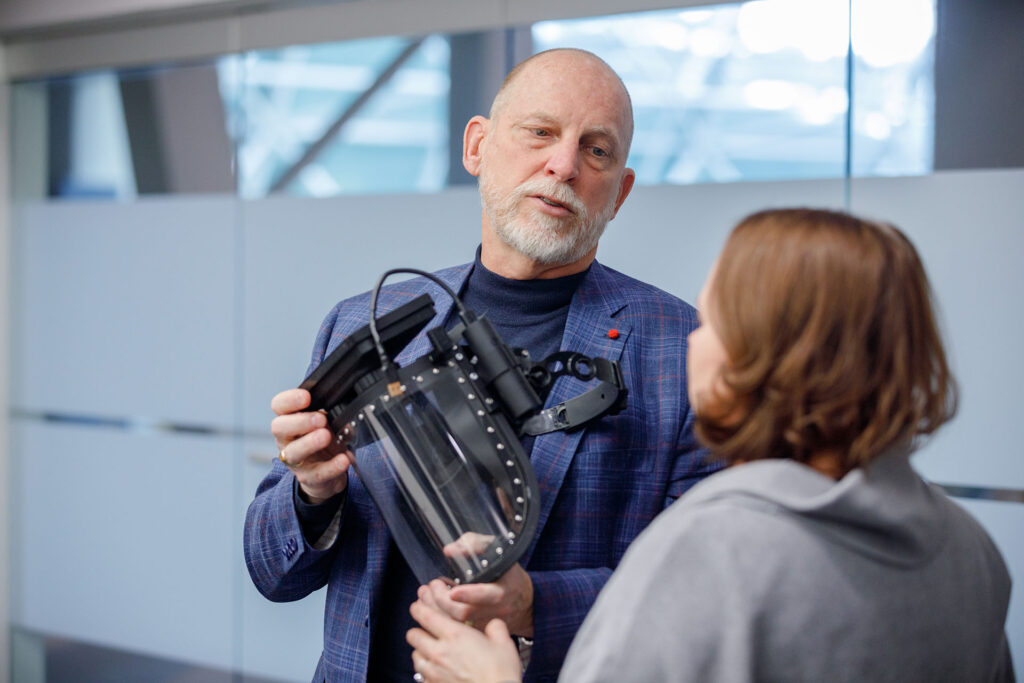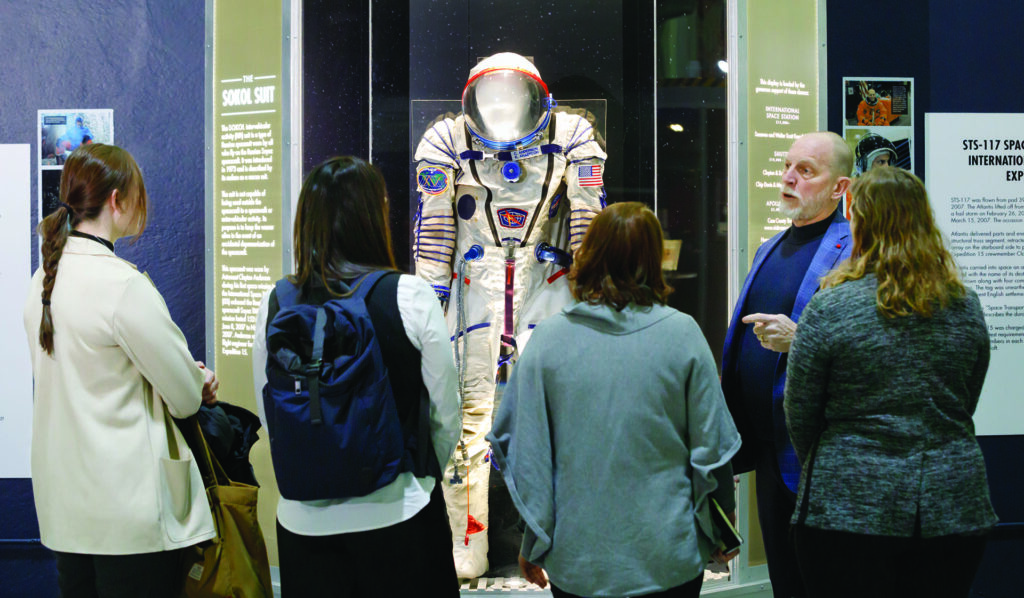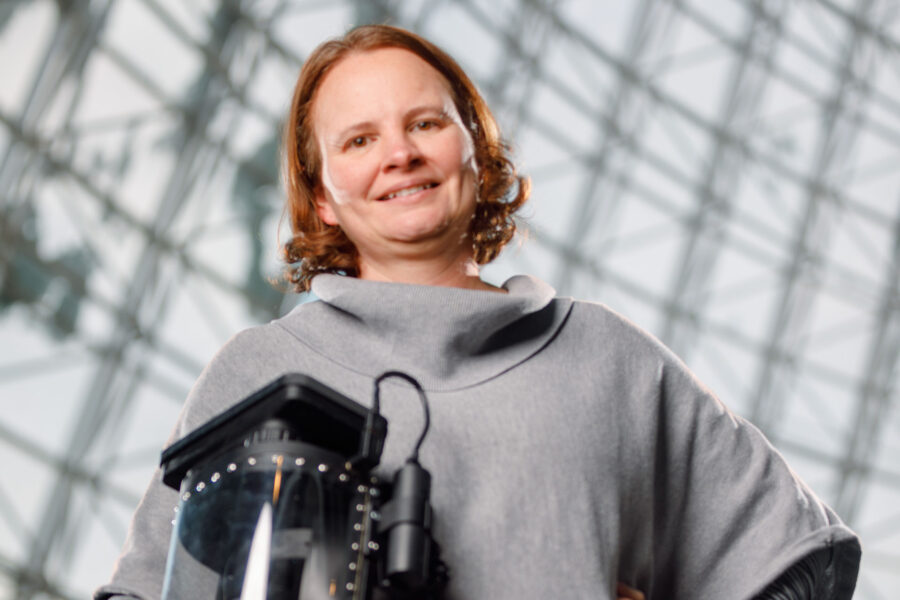The University of Nebraska Medical Center boasts a formidable cohort of women who drive scientific exploration and advance modern medicine in Nebraska and beyond. These visionary researchers and innovators are propelled by grit, resilience and personal resolve to “find a better way.” Among them: Beth Beam, PhD; Rebekah Gundry, PhD; Breanna Hetland, PhD; and Hongying “Daisy” Dai, PhD.
They were featured in the 2024 spring edition of UNMC Connect. See the online version of the publication at this link.
PPE, Prototypes & Persistence
As a young child, Beth Beam, PhD, observed her grandparents’ unwavering dedication in caring for her great-grandmother at home. As certified nursing assistants, their compassionate example turned the budding STEM enthusiast toward a career in nursing.
Dr. Beam, an Omaha native, entered nursing studies in the late 1990s with an eye toward oncology. She became interested in nursing science while studying fatigue among caregivers and patients undergoing bone marrow transplants. This led to her first job as an oncology research coordinator at UNMC’s Lied Transplant Center.
When Hurricane Katrina hit New Orleans in August 2005, Dr. Beam found herself pivoting in an unexpected direction. “Emergency preparedness was just emerging, and everybody was grasping at straws,” she said.
The UNMC College of Nursing received a grant to create interactive videos and simulation drills for bioterrorism and public health emergencies. Dr. Beam, a teaching assistant, joined the project team led by simulation pioneer Patti Carstens.
“Don’t get so bogged down in what’s hard about your work every day that you forget about what’s possible. You may be sitting on the next big idea that will change everything.”
– Beth Beam, PhD
•••
The HEROES project’s first phase included development of a website primarily for health-care professionals and first responders. Dr. Beam managed the resources section, covering crucial topics like isolation procedures, hazardous material management and mass casualty responses.
During the launch of the HEROES project, Dr. Beam became involved in the Nebraska Biocontainment Unit, led by Phil Smith, MD, a pioneer in biopreparedness and infectious disease research and treatment. Dr. Beam had a career-defining experience serving as the unit’s educator when the Ebola crisis hit in 2014 and UNMC and Nebraska Medicine successfully treated three patients infected with the West African virus.
“There was a mix of excitement and trepidation,” Dr. Beam said, as frontline responders donned the personal protective equipment ensemble developed by her and her colleagues.
It also was a uniquely significant time for Dr. Beam on a personal level. “I was pregnant and remained outside the unit to stay safe at Dr. Smith’s insistence.”
She concentrated on disseminating information in partnership with the UNMC Colleges of Nursing and Allied Health Professions and the Center for Biopreparedness Education. “We received phone calls from people all over the world,” she said. The HEROES website, now her responsibility as project director, became a critical resource for accessing life-saving tutorials and protocols on demand. The Centers for Disease Control and Prevention linked to the HEROES website before their guidance for Ebola protective equipment was ready.
In 2020, at the start of the COVID-19 pandemic, the biocontainment unit again was activated, for care and management of U.S. citizens from Wuhan, China, and the Diamond Princess Cruise ship.

This time, respiratory protection became Dr. Beam’s primary focus. “It’s the invisible things that can get us,” she said, referencing her work to refine the design and functionality of the suits and head-mounted air-purifying respirators worn by caregivers in quarantine units. “There has to be a better way.”
A UNeMed grant gave birth to a 3-D printed prototype helmet currently undergoing critique by health-care professionals and others, including National Institute of Occupational Safety and Health experts and Nebraska’s astronaut, Clayton C. Anderson.
Dr. Beam and her research team spent a January afternoon with Anderson at the Strategic Air Command & Aerospace Museum near Ashland, Nebraska, delving into the intricacies of spacewalk suits and helmets and getting his feedback on the prototype.
“Not bad. Cool,” he said as he donned the helmet and drew a comparison to a 3M ammonia mask. They agreed: “The simpler in design PPE can be, the safer people will be,” especially in high-stress situations.

•••
During her undergraduate years, Dr. Beam considered a career in architectural design and dabbled in computer-aided drafting. Today, those interests are valuable in the prototype lab, but her true passion lies in nursing. A registered nurse, she earned her BSN in 2000, followed by an MSN in 2004 and a PhD in 2014, all from UNMC.
Throughout the journey, Dr. Beam faced personal challenges, including the losses of her firstborn, Glen Allen, in 2010, and second child, Christian James, in 2014. Despite these tragedies, she found joy in motherhood with the arrival of Bradley in 2015, coinciding with the Ebola crisis and the completion of the dissertation for her PhD degree.
Backed by her husband and son and buoyed by the guidance of mentors and camaraderie of peers, Dr. Beam shares her experience and expertise as an associate professor of nursing and an education researcher with UNMC’s Interprofessional Academy of Educators. Additionally, she contributes to various federally funded grants supporting Ebola and other high-consequence pathogens.
“There are so many places that nurses can make an impact,” she said. As a nurse scientist, “I know a little about a lot of things,” which comes in handy as a problem-solver. “Health care protocols can be daunting,” she said. “The reward is looking at the pain points and considering innovations that work.”

Good story about an incredible woman! It is always a pleasure to work with Dr. Beam, I learn from her in every interaction. Glad to see UNMC today highlighting our own amazing colleagues.
Kudos Dr. Beam for your vision, innovation, and collaboration!
Congratulations Beth for being recognized as a true leader!
Great work, Beth! It’s a pleasure to know and work with you.
I have enjoyed our collaborations over the years, and this is a well-deserved honor to be recognized!
Congratulations Beth!! I am so excited to see your work recognized!
Beth, so happy to see you recognize for all the amazing work you have done. You’ve been great to work with!
Beth,
It is great to see your contributions recognized. You accomplished much in spite of real hardships. Thank you for your help with Ebola!
Congratulations Dr. Beam!
Congratulations, Dr. Beam!
Dr. Beam is an incredible person and scholar!